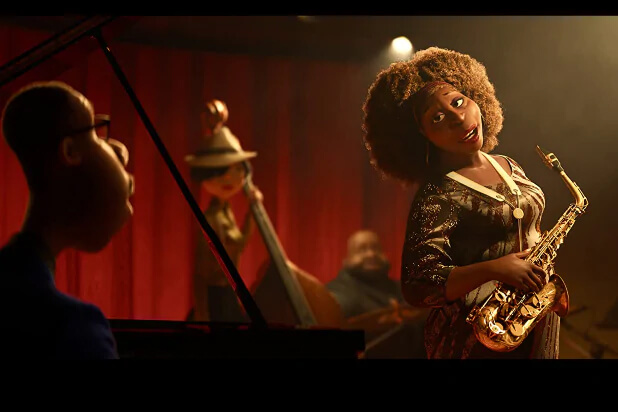You have to wait until nearly the end of the scrolling credits to see who the musicians are who represent the on-screen characters in Disney’s new animated movie, Soul. The movie is about a jazz pianist, Joe Gardner (voiced by Jamie Foxx), who snags the gig of a lifetime, dies in an accident, and then strives to return his soul to his body while in the company of a disembodied soul (Tina Fey) from the Great Before who is both the main antagonist in the movie and a very Disney-fied plot complication.
At the start of the movie, Joe is teaching music in middle school, doing the best he can, and both happy and disappointed to find out that he’s been hired full time by the school district. The weight of his ambivalence, the texture of the classroom and the details of his instructions, the relief over landing a steady job and the loss of giving up the most important thing, being a performing musician, is one of the truest jazz moments in the movie—jazz takes so much and delivers so little (in the way of money) the musicians play it because they have to, because it’s so deeply meaningful, and more than a few have lived in the type of dire straits that exhaust the capacity to play the music. Giving up the thing you most want for the thing you most need is a pretty consistent feature of jazz history.
The next moment of jazz truth comes when Gardner is sitting at the piano in a basement club that is clearly modeled after the Village Vanguard (a year without the Vanguard, with more waiting time ahead, adds piquancy to the utter gorgeousness of the animation, which features wonderful character details, even in the extras, and beauty and subtlety in the lighting that rivals anything you will see on the big or small screen). He’s auditioning as a last-minute replacement for the pianist in saxophonist Dorothea Williams’ (voiced by Angela Bassett), group. It’s Tia Fuller who’s actually playing the alto sax, and when she blows the first few notes through the horn, I felt a charge of lightning run through me—coming through my iPad’s screen and speakers, Fuller’s sound was so intense and full of inner fire that it sounded alive. The moment felt like being in a club, a band on the stand, the molecules of sound pushing toward me.
Soul is a jazz movie, and it’s a good jazz movie and the jazz is good. It’s other things too, of course, more problematic in that they involve the first Black main character that Disney/Pixar has ever produced and the missteps involving representation that come about when you have a white woman enter into a Black man’s body and the Black man end up in…a cat. As Damon Young, who enjoyed the movie, wrote at The Root, Soul may be a movie about a “Black guy, but it is not a Black movie… And it feels like the bulk of the disappointments with it stem from that point. Which is a valid one. Soul was not originally conceived to be about a Black character and that construction is obvious with some of the choices in it.”
Nor was it conceived necessarily as a jazz movie. it seems the original idea involved a scientist and the clichéd and bogus opposition between head and heart. But a jazz movie it became, and in the Year of No Live Music (pace David Foster Wallace), a welcome presence it was when it appeared on Disney+ on Christmas Day. The jazz is good, the original music composed by Jon Batiste, who also plays the piano, and along with Fuller the band in the movie is Linda May Han Oh playing bass and Roy Haynes and Marcus Gilmore at the drums. One of the nice details is that Williams’ drummer, an old student of Gardner’s, is a young Black guy, and the bassist is a young Asian woman, the animated characters representing the actual musicians. Much of the movie takes place in the Great Before, where souls are formed before they are placed into newborn babies, and the music for those sequences is another fine electronic score from Trent Reznor and Atticus Finch, but all the music in New York City is jazz.
What a pleasure to experience live jazz again! Except, of course, I know the music isn’t live, but there’s something about the magic of movies where seeing musicians play, even animated ones, produces the convincing illusion in the senses that the music is happening right there, in the moment. Credit must go to the musicians too, because with players this good the music explodes out of the speakers in a special way.
The music is so alive that when, after Joe earns the gig, it is genuinely upsetting when Joe falls into an uncovered manhole and dies (Soul, like Up, is pitched in the direction of kids but is fine for adults). It happens fast and before you know enough about him to feel the sense of personal tragedy. It’s the music that makes the death so effecting, because the music had been so alive and exciting, feeling like it was going to burst out into spontaneous variations, which is how all the great live jazz albums sound, even when you’ve heard them dozens of times already.
Things work out in the end, but that initial heady rush of excitement doesn’t come back. Except for experience junkies, that’s not a criticism, it means that the movie establishes a bona fide jazz world, where descending a set of stairs off the street and into the club gathers an anticipatory feeling that is rewarded by the excited rush of the first few notes. That quickly settles into a groove of listening very much like one that a band may be laying down, a kind of steady, loping rise and plateauing of satisfactions. The live jazz experience. It’s still going to be awhile before we can have that again, and in the meantime you can do a lot worse than sitting down for a session of Soul.
Author
-

George Grella wrote the book on Miles Davis’ Bitches Brew. He write other stuff too. killyridols.substack.com/
View all posts
George Grella wrote the book on Miles Davis’ Bitches Brew. He write other stuff too. killyridols.substack.com/











